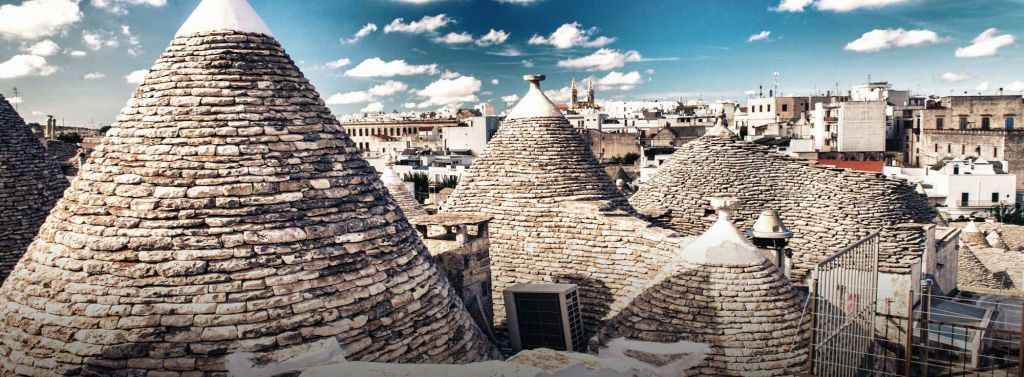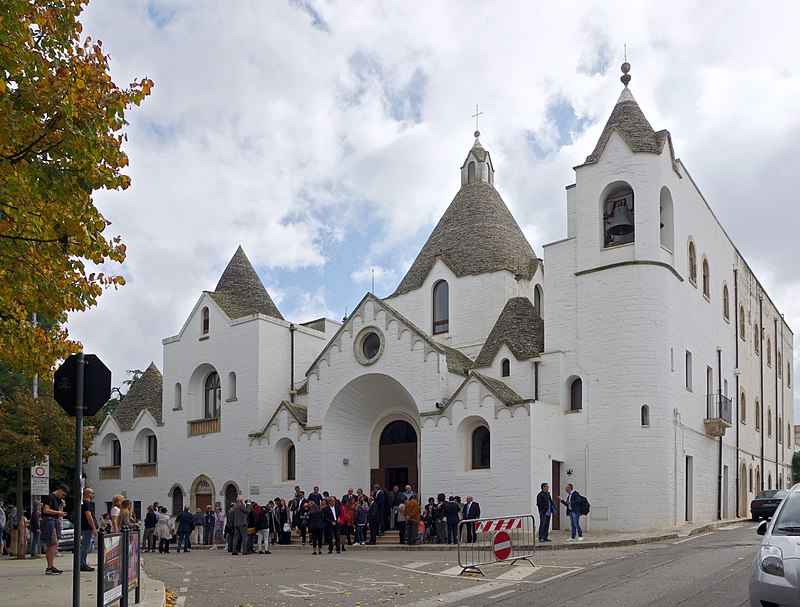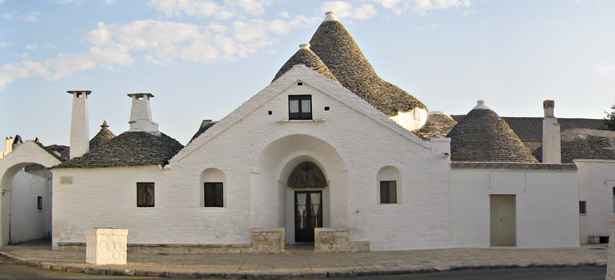




The impressive trulli of Alberobello were recognized as a World Heritage Site in 1996 and awarded with the Orange Flag by the Italian Touring Club by virtue of its excellent accommodation and architectural harmony. Winding alleyways and characteristic small squares intertwine in the Rione Monti, where the "Siamese trulli" are distinguished, from the original two-cone roof, the Church of Sant’Antonio and the Trullo Sovrano. Don't miss the Museo del Territorio, housed in a complex of communicating trulli, and the Casa d’Amore, today a valuable tourist information point, the first building in the entire town built with lime and mortar. Less frequented than the Monti district but no less interesting is the historic district Aia Piccola
 This splendid trullo church of the early twentieth century stands out on top of Rione Monti. After admiring the evocative forest of trulli, almost crowning the historic area called Rione Monte, stands the Church of Sant'Antonio. The sacred place, built in fourteen months between 1926 and 1927, shows the signs of the strong popular devotion of the inhabitants of Alberobello. Built thanks to the convinced action of Don Antonio Lippolis, to counter the spread of Protestantism, the cult building was designed by the engineer Signorile Bianchi and created by the art master Martino De Leonardis, following the indications provided by a special committee set up to safeguard the integrity of the monumental area. In limestone and built with the typical technique of trulli (of which reproduces the conical vault), this church is proposed as a connection point and mediation between past and present, ancient and modern.
This splendid trullo church of the early twentieth century stands out on top of Rione Monti. After admiring the evocative forest of trulli, almost crowning the historic area called Rione Monte, stands the Church of Sant'Antonio. The sacred place, built in fourteen months between 1926 and 1927, shows the signs of the strong popular devotion of the inhabitants of Alberobello. Built thanks to the convinced action of Don Antonio Lippolis, to counter the spread of Protestantism, the cult building was designed by the engineer Signorile Bianchi and created by the art master Martino De Leonardis, following the indications provided by a special committee set up to safeguard the integrity of the monumental area. In limestone and built with the typical technique of trulli (of which reproduces the conical vault), this church is proposed as a connection point and mediation between past and present, ancient and modern.
The imposing tripartite façade is dominated by a rose window and three tympanums with hanging arches, which recall the decorations of the Apulian Romanesque churches. On the right side stands a tall bell tower (18.90 meters) and on the left the seminary, initially a summer residence for the young clerics of the Diocese, was later transformed into a tourist accommodation facility. The interior has a single hall, with a Greek cross plan surmounted by a dome about 20 meters high. The main apse was entirely frescoed in the 20th century with the representation of the Tree of Life, enriched by the majestic Crucifix by the master Adolfo Rollo.
 In the northern area of Alberobello, behind the Church of the Saints Cosma and Damiano, the Trullo Sovrano is the only example of a two-story trullo. The trullo, which boasts authentic furnishings and objects inside, was declared a National Monument in 1923 while in 1996 it was included in the list of Unesco sites.
In the northern area of Alberobello, behind the Church of the Saints Cosma and Damiano, the Trullo Sovrano is the only example of a two-story trullo. The trullo, which boasts authentic furnishings and objects inside, was declared a National Monument in 1923 while in 1996 it was included in the list of Unesco sites.
It was built in the first half of the 18th century at the behest of the family of the priest Cataldo Perta, who used it as his home, while the surrounding trulli were inhabited by its employees. The great trullo was defined as "Sovereign" by the historic Notarnicola, to highlight its majesty compared to the other trulli. With its majestic 14-meter high conical dome that rises imposingly in the center of a group of 12 cones, the Sovereign Trullo was built by an anonymous masonry master who, while respecting the ancient constraints imposed by Count Giangirolamo Acquaviva, developed some unique construction solutions that make this building the most advanced and audacious interpretation of the trullo, inaugurating the new "a cotto" construction phase, that is with the use of mortar and no longer with dry stones only.
The elegant minor basilica of Alberobello stands out in the center of the city with the spiers of the bell towers that rise between the domes of the trulli. Near the Trullo Sovrano, at the end of the central Corso Vittorio Emanuele, the Sanctuary of the Saints Cosmas and Damian stands majestically in the place where a small rural church dedicated to the Madonna delle Grazie stood. The splendid minor basilica is a beautiful example of neoclassical style.
